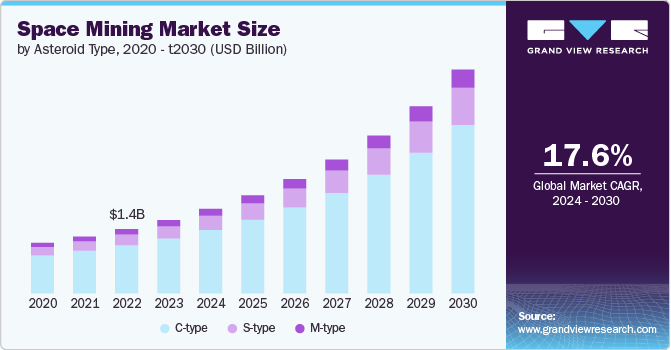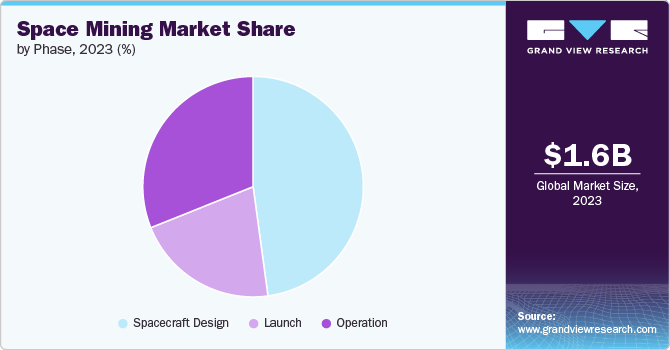
Space Mining Market Size, Share & Trends Analysis Report By Asteroid Type (C-Type, S-Type, M-Type), By Phase (Spacecraft Design, Launch, Operation), By Region (North America, Asia Pacific), And Segment Forecasts, 2024 - 2030
- Report ID: GVR-4-68040-338-1
- Number of Report Pages: 85
- Format: PDF
- Historical Range: 2018 - 2022
- Forecast Period: 2024 - 2030
- Industry: Advanced Materials
Space Mining Market Size & Trends
The global space mining market size was estimated at USD 1.64 billion in 2023 and is estimated to grow at a CAGR of 17.6% from 2024 to 2030. The surge in investments for space mining activities is expected to drive the market. These investments are supported by the convergence of technological advancements, increasing private sector interest, and strategic anticipation for future resource demands. The advancement has lowered the capital cost for space mining activities and is expected to support the market growth.

Advancements in technology have significantly reduced the barriers to accessing space, making it feasible for private and government companies to explore space resources. This technological advancement includes more efficient propulsion systems, reusable rockets, and robotics and automation, which are expected to assist in cost-effective missions to asteroids and other minerals such as platinum, gold, and rare earth elements.
Drivers, Opportunities & Restraints
The increasing scarcity of Earth-bound resources has spurred interest in space mining as a viable solution to meet global demand. With resources becoming more expensive to extract and depleting at an alarming rate, mining asteroids and other celestial bodies offers a promising alternative. This potential to access vast quantities of metals and minerals in space not only promises economic benefits but is also expected to reduce the environmental impact associated with traditional mining practices on Earth.
Access to rare and valuable resources owing to space mining represents a lucrative opportunity for industries and economies worldwide. Asteroids and other celestial bodies are believed to contain vast quantities of precious metals like platinum, gold, and rare earth elements, which are critical for advanced technologies ranging from electronics to renewable energy systems.
The high initial costs associated with space mining operations act as a restraint to market growth. Establishing infrastructure for resource extraction requires significant investment in advanced spacecraft, robotic systems, and specialized mining equipment to operate in harsh environments like asteroids or the Moon. These technologies must be not only capable of extraction but also transportation back to Earth or other destinations, which further increases costs.
Asteroid Type Insights & Trends
“C-Type held the largest revenue share of over 75.0% in 2023.”
C-type asteroids, also known as carbonaceous asteroids segment are expected to observe rising investments on account of their composition rich in volatiles such as water, ammonia, and carbon-based compounds. These asteroids are valuable for their potential to provide resources essential for sustaining life in space habitats and supporting deep-space missions. Water extracted from C-type asteroids can serve as a critical resource for drinking, agriculture, and manufacturing propellant for spacecraft over the coming years.
S-type asteroids have stony appearance and higher metal content compared to C-type asteroids. They are important resources in space mining industry for their potential to yield valuable metals such as nickel, iron, and cobalt. These asteroids can be used in industries requiring metals for manufacturing and technological applications both in space and on Earth.
Phase Insights
“Spacecraft design held over 47% revenue share of the overall Asia Pacific space mining market.”
Spacecraft design phase is expected to observe increasing investments over the coming years. Design in space mining involves integrating robust technologies capable of operating harsh environment of space. These spacecraft need advanced propulsion systems for maneuverability and efficient travel to distant asteroids or planetary bodies. Additionally, they require sophisticated navigation and guidance systems to navigate complex trajectories and safely approach mining targets.

Operating spacecraft in the space mining market requires meticulous planning and execution. Once deployed, these spacecraft autonomously survey potential mining sites, using onboard sensors to assess resource composition and abundance. Advanced robotic arms and drills are used to extract materials from asteroids or planetary surfaces, utilizing precision mining techniques to maximize resource recovery.
Region Insights
North America space mining market held over 80% revenue share of the global space mining industry. North America is anticipated to lead space mining market with significant investments in technology and infrastructure. Companies in the region focus on developing advanced spacecraft and robotic technologies for efficient resource extraction from asteroids and the Moon. Supportive regulatory frameworks for private sector companies are also anticipated to act as contributing factors for the market growth.
U.S. Space Mining Market Trends
Collaborations between space organizations, research institutions, and private companies are expected to increase investments in space mining in the U.S. The country is significantly advanced in aerospace engineering and satellite communications, which is anticipated to remain a vital factor for the market growth.
Asia Pacific Space Mining Market Trends
The space mining market in Asia Pacific is likely to observe rising capital expenditure for space mining activities in countries like Japan. The region's strong manufacturing base and expertise in robotics are anticipated to benefit the market growth over the coming years.
Europe Space Mining Market Trends
The space mining market in Europe is expected to observe significant investments. The companies in the region are utilizing their expertise in robotics, automation, and materials science to develop technology for space mining and improve their footprint in this emerging market.
Key Space Mining Company Insights:
Some of the key players operating in market include Planetary Resources, Deep Space Industries and Moon Express.
-
Planetary Resources is involved in space mining activities and has plans to explore and utilize the resources from asteroids. The company’s key focus is to extract key resources such as water and precious metals.
-
Deep Space Resources is U.S. based private company, which is involved in space exploration activities. The company plans to build spacecraft technology that will enable space exploration and will reduce the costs involved in space mining.
Key Space Mining Companies:
The following are the leading companies in the space mining market. These companies collectively hold the largest market share and dictate industry trends.
- Asteroid Mining Corporation
- Deep Space Resources
- European Space Agency
- ispace
- Moon Express
- Offworld
- Planetary Resources
- Spacefab US
- Transastra
Recent Developments
-
In October 2023, Space Exploration Technologies Corporation along with NASA, launched a mission to asteroid belt between Jupiter and Mars. This will enable the companies to understand unexplored blocks of iron cores.
-
In January 2023, Astroforge Inc. announced its plans to launch spacecraft for exploration of platinum group metals and to reduce the cost of mining these metals.
Space Mining Market Report Scope
|
Report Attribute |
Details |
|
Market size value in 2024 |
USD 1.90 billion |
|
Revenue forecast in 2030 |
USD 5.02 billion |
|
Growth Rate |
CAGR of 17.6% from 2024 to 2030 |
|
Base year for estimation |
2023 |
|
Historical data |
2018 - 2022 |
|
Forecast period |
2024 - 2030 |
|
Quantitative Units |
Revenue in USD million/billion, and CAGR from 2024 to 2030 |
|
Report coverage |
Revenue forecast, competitive landscape, growth factors, and trends |
|
Segments covered |
Asteroid type, phase, and region |
|
Regional scope |
North America; Europe; Asia Pacific |
|
Key companies profiled |
Asteroid Mining Corporation; Deep Space Resources; European Space Agency; ispace; Moon Express; Offworld; Planetary Resources; Spacefab US; and Transastra
|
|
Customization scope |
Free report customization (equivalent up to 8 analysts working days) with purchase. Addition or alteration to country, regional & segment scope. |
|
Pricing and purchase options |
Avail customized purchase options to meet your exact research needs. Explore purchase options |
Global Space Mining Market Report Segmentation
This report forecasts revenue growth at global and regional levels and provides an analysis of the latest trends in each of the sub-segments from 2018 to 2030. For this study, Grand View Research has segmented the global space mining market report on the basis of asteroid type, phase, and region.
-
Asteroid Type Outlook (Revenue, USD Million, 2018 - 2030)
-
C-type
-
S-type
-
M-type
-
-
Phase Outlook (Revenue, USD Million, 2018 - 2030)
-
Spacecraft Design
-
Launch
-
Operation
-
-
Regional Outlook (Revenue, USD Million, 2018 - 2030)
-
North America
-
Europe
-
Asia Pacific
-
Frequently Asked Questions About This Report
b. The global space mining market size was estimated at USD 1.64 billion in 2023 and is expected to reach USD 1.90 billion in 2024.
b. The global space mining market is expected to grow at a compound annual growth rate of 17.6% from 2024 to 2030 to reach USD 5.02 billion by 2030.
b. By asteroid type, c-type dominated the market with a revenue share of over 75% in 2023.
b. Some of the key vendors of the global space mining market are Asteroid Mining Corporation, Deep Space Resources, European Space Agency, ispace, Moon Express, Offworld, Planetary Resources, Spacefab US, and Transastra
b. The key factor driving the growth of the global space mining market is the rising investments in space mining activities to explore resources from asteroids
We are committed towards customer satisfaction, and quality service.
"The quality of research they have done for us has been excellent."




